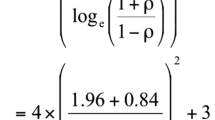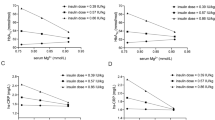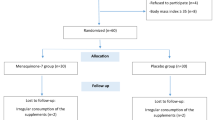Abstract
Background/Objectives:
To determine the interrelationships between body composition, glycemic control and vitamin D status in an ambulatory population with diabetes (DM) and chronic kidney disease (CKD).
Subjects/Methods:
Adult (18–80 years) patients (n=60) with DM and stage 1–4 CKD were recruited from the Northern Alberta Renal Program. Outcome variables included body composition (absolute/regional fat (FM)/lean soft tissue/total mass, percent fat/lean/fat-free (FFM) mass), glycemic control (glycated hemoglobin (HbA1c)), vitamin D intake (dietary/supplemental) and vitamin D status (25-hydroxyvitamin D (25(OH)D) and 1,25-dihydroxyvitamin D (1,25(OH)2D)) measured by validated methodologies. Sarcopenia was determined as an appendicular skeletal mass/height2 less than 7.26 kg/m2 (males) and 5.45 kg/m2 (females).
Results:
Suboptimal HbA1c (>7%), 25(OH)D (<50 nmol/l) and 1,25(OH)2D (<43 pmol/l) concentrations were present in 57, 8 and 11% of participants. Ten percent of subjects had sarcopenia. Gender/age/DM type, not CKD, significantly influenced regional/whole body composition. Females, older participants and those with type 2 DM had higher %FM. No significant interrelationships between vitamin D status and glycemic control were observed (P>0.05). Serum 25(OH)D concentrations were inversely associated with arm lean soft tissue/FFM/total mass, weight, appendicular skeletal mass, lean soft tissue/height2, FFM/height2, appendicular skeletal mass/height2 and body mass index (P<0.05). Sarcopenia occurred more frequently in patients with 25(OH)D concentrations ⩾100 nmol/l. Regional/whole body %FM was inversely related to 1,25(OH)2D, not 25(OH)D.
Conclusions:
Body composition, not glycemic control, is associated with vitamin D status in an ambulatory population of adults with DM and CKD.
This is a preview of subscription content, access via your institution
Access options
Subscribe to this journal
Receive 12 print issues and online access
$259.00 per year
only $21.58 per issue
Buy this article
- Purchase on Springer Link
- Instant access to full article PDF
Prices may be subject to local taxes which are calculated during checkout
Similar content being viewed by others
References
Stipanuk MH, Caudill MA . Biochemical, Physiological, and Molecular Aspects of Human Nutrition, 3rd edn. Elsevier Inc. Saunders: St Louis, MO, 2013.
Munker R, Norman A, Koeffler HP . Vitamin D compounds. Effect on clonal proliferation and differentiation of human myeloid cells. J Clin Invest 1986; 78: 424–430.
Mathieu C, Adorini L . The coming of age of 1,25-dihydroxyvitamin D(3) analogs as immunomodulatory agents. Trends Mol Med 2002; 8: 174–179.
Zittermann A, Schleithoff SS, Koerfer R . Putting cardiovascular disease and vitamin D insufficiency into perspective. Br J Nutr 2005; 94: 483–492.
Rucker D, Tonelli M, Coles MG, Yoo S, Young K, McMahon AW . Vitamin D insufficiency and treatment with oral vitamin D3 in northern-dwelling patients with chronic kidney disease. J Nephrol 2009; 22: 75–82.
Rucker D, Allan JA, Fick GH, Hanley DA . Vitamin D insufficiency in a population of healthy western Canadians. CMAJ 2002; 166: 1517–1524.
Malabanan A, Veronikis IE, Holick MF . Redefining vitamin D insufficiency. Lancet 1998; 351: 805–806.
Saha H . Calcium and vitamin D homeostasis in patients with heavy proteinuria. Clin Nephrol 1994; 41: 290–296.
Dworatzek PD, Arcudi K, Gougeon R, Husein N, Sievenpiper JL, Williams SL . Nutrition therapy. Can J Diabetes 2013; 37: S45–S55.
Maestro B, Campion J, Davila N, Calle C . Stimulation by 1,25-dihydroxyvitamin D3 of insulin receptor expression and insulin responsiveness for glucose transport in U-937 human promonocytic cells. Endocr J 2000; 47: 383–391.
Rabinovitch A, Suarez-Pinzon WL, Sooy K, Strynadka K, Christakos S . Expression of calbindin-D(28k) in a pancreatic islet beta-cell line protects against cytokine-induced apoptosis and necrosis. Endocrinology 2001; 142: 3649–3655.
Wolden-Kirk H, Overbergh L, Gysemans C, Brusgaard K, Naamane N, Van Lommel L et al. Unraveling the effects of 1,25OH2D3 on global gene expression in pancreatic islets. J Steroid Biochem Mol Biol 2013; 136: 68–79.
Lin Y, Sun Z . Antiaging gene Klotho enhances glucose-induced insulin secretion by up-regulating plasma membrane levels of TRPV2 in MIN6 beta-cells. Endocrinology 2012; 153: 3029–3039.
Alley DE, Chang VW . The changing relationship of obesity and disability, 1988-2004. JAMA 2007; 298: 2020–2027.
Baumgartner RN, Wayne SJ, Waters DL, Janssen I, Gallagher D, Morley JE . Sarcopenic obesity predicts instrumental activities of daily living disability in the elderly. Obes Res 2004; 12: 1995–2004.
Cruz-Jentoft AJ, Baeyens JP, Bauer JM, Boirie Y, Cederholm T, Landi F et al. Sarcopenia: European consensus on definition and diagnosis: report of the European Working Group on Sarcopenia in Older People. Age Ageing 2010; 39: 412–423.
Flegal KM, Graubard BI, Williamson DF, Gail MH . Excess deaths associated with underweight, overweight, and obesity. JAMA 2005; 293: 1861–1867.
Gale CR, Martyn CN, Cooper C, Sayer AA . Grip strength, body composition, and mortality. Int J Epidemiol 2007; 36: 228–235.
Lang IA, Llewellyn DJ, Alexander K, Melzer D . Obesity, physical function, and mortality in older adults. J Am Geriatr Soc 2008; 56: 1474–1478.
Whitlock G, Lewington S, Sherliker P, Clarke R, Emberson J, Halsey J et al. Body-mass index and cause-specific mortality in 900 000 adults: collaborative analyses of 57 prospective studies. Lancet 2009; 373: 1083–1096.
Villareal DT, Banks M, Siener C, Sinacore DR, Klein S . Physical frailty and body composition in obese elderly men and women. Obes Res 2004; 12: 913–920.
Maric C, Hall JE . Obesity, metabolic syndrome and diabetic nephropathy. Contrib Nephrol 2011; 170: 28–35.
Aubertin-Leheudre M, Lord C, Goulet ED, Khalil A, Dionne IJ . Effect of sarcopenia on cardiovascular disease risk factors in obese postmenopausal women. Obesity (Silver Spring) 2006; 14: 2277–2283.
Arunabh S, Pollack S, Yeh J, Aloia JF . Body fat content and 25-hydroxyvitamin D levels in healthy women. J Clin Endocrinol Metab 2003; 88: 157–161.
Moschonis G, Tanagra S, Koutsikas K, Nikolaidou A, Androutsos O, Manios Y . Association between serum 25-hydroxyvitamin D levels and body composition in postmenopausal women: the postmenopausal Health Study. Menopause 2009; 16: 701–707.
Wortsman J, Matsuoka LY, Chen TC, Lu Z, Holick MF . Decreased bioavailability of vitamin D in obesity. Am J Clin Nutr 2000; 72: 690–693.
Boland R . Vitamin D and Muscle. Vitamin D, 2nd edn. Academic Press: CA, USA, 2005.
Rosen CJ, Adams JS, Bikle DD, Black DM, Demay MB, Manson JE et al. The nonskeletal effects of vitamin D: an Endocrine Society scientific statement. Endocr Rev 2012; 33: 456–492.
Scott D, Ebeling PR, Sanders KM, Aitken D, Winzenberg T, Jones G . Vitamin D and physical activity status: associations with five-year changes in body composition and muscle function in community-dwelling older adults. J Clin Endocrinol Metab 2015; 100: 670–678.
Capozza RF, Cure-Cure C, Cointry GR, Meta M, Cure P, Rittweger J et al. Association between low lean body mass and osteoporotic fractures after menopause. Menopause 2008; 15: 905–913.
Mafra D, Guebre-Egziabher F, Fouque D . Body mass index, muscle and fat in chronic kidney disease: questions about survival. Nephrol Dial Transplant 2008; 23: 2461–2466.
Souza VA, Oliveira D, Mansur HN, Fernandes NM, Bastos MG . Sarcopenia in chronic kidney disease. J Bras Nefrol 2015; 37: 98–105.
Johansen KL, Lee C . Body composition in chronic kidney disease. Curr Opin Nephrol Hypertens 2015; 24: 268–275.
Patterson E . Guidelines for Data Processing and Analysis of the International Physical Activity Questionnaire (IPAQ) – Short and Long Forms 2005, Available from http://www.institutferran.org/documentos/scoring_short_ipaq_april04.pdf.
Batsis JA, Mackenzie TA, Barre LK, Lopez-Jimenez F, Bartels SJ . Sarcopenia, sarcopenic obesity and mortality in older adults: results from the National Health and Nutrition Examination Survey III. Eur J Clin Nutr 2014; 68: 1001–1007.
Prado CM, Siervo M, Mire E, Heymsfield SB, Stephan BC, Broyles S et al. A population-based approach to define body-composition phenotypes. Am J Clin Nutr 2014; 99: 1369–1377.
Baumgartner RN . Body composition in healthy aging. Ann NY Acad Sci 2000; 904: 437–448.
Freedman LS, Midthune D, Carroll RJ, Krebs-Smith S, Subar AF, Troiano RP et al. Adjustments to improve the estimation of usual dietary intake distributions in the population. J Nutr 2004; 134: 1836–1843.
Day N, McKeown N, Wong M, Welch A, Bingham S . Epidemiological assessment of diet: a comparison of a 7-day diary with a food frequency questionnaire using urinary markers of nitrogen, potassium and sodium. Int J Epidemiol 2001; 30: 309–317.
Imran SA, Rabasa-Lhoret R, Ross S . Targets for glycemic control. Can J Diabetes 2013; 37: S31–S34.
Holick MF, Binkley NC, Bischoff-Ferrari HA, Gordon CM, Hanley DA, Heaney RP et al. Evaluation, treatment, and prevention of vitamin D deficiency: an Endocrine Society clinical practice guideline. J Clin Endocrinol Metab 2011; 96: 1911–1930.
Institute of Medicine (US) Committee to Review Dietary Reference Intakes for Vitamin D and CalciumIn: Ross AC, Taylor CL, Yaktine AL et al. (eds). Dietary Reference Intakes for Calcium and Vitamin D. 5, National Academies Press: Washington, DC, 2011.
Scott D, Blizzard L, Fell J, Ding C, Winzenberg T, Jones G . A prospective study of the associations between 25-hydroxy-vitamin D, sarcopenia progression and physical activity in older adults. Clin Endocrinol (Oxf) 2010; 73: 581–587.
Aghili R, Malek M, Valojerdi AE, Banazadeh Z, Najafi L, Khamseh ME . Body composition in adults with newly diagnosed type 2 diabetes: effects of metformin. J Diabetes Metab Disord 2014; 13: 88.
Waters DL, Yau CL, Montoya GD, Baumgartner RN . Serum sex hormones, IGF-1, and IGFBP3 exert a sexually dimorphic effect on lean body mass in aging. J Gerontol A Biol Sci Med Sci 2003; 58: 648–652.
Perry AC, Martin L . Race differences in obesity and its relationship to the sex hormone milieu. Horm Mol Biol Clin Investig 2014; 19: 151–161.
McGregor RA, Cameron-Smith D, Poppitt SD . It is not just muscle mass: a review of muscle quality, composition and metabolism during ageing as determinants of muscle function and mobility in later life. Longev Healthspan 2014; 3: 9.
Migliaccio S, Greco EA, Aversa A, Lenzi A . Age-associated (cardio)metabolic diseases and cross-talk between adipose tissue and skeleton: endocrine aspects. Horm Mol Biol Clin Investig 2014; 20: 25–38.
Menon MK, Houchen L, Harrison S, Singh SJ, Morgan MD, Steiner MC . Ultrasound assessment of lower limb muscle mass in response to resistance training in COPD. Respir Res 2012; 13: 119.
Parikh SJ, Edelman M, Uwaifo GI, Freedman RJ, Semega-Janneh M, Reynolds J et al. The relationship between obesity and serum 1,25-dihydroxy vitamin D concentrations in healthy adults. J Clin Endocrinol Metab 2004; 89: 1196–1199.
Ding C, Parameswaran V, Blizzard L, Burgess J, Jones G . Not a simple fat-soluble vitamin: changes in serum 25-(OH)D levels are predicted by adiposity and adipocytokines in older adults. J Intern Med 2010; 268: 501–510.
Lappe JM, Binkley N . Vitamin D and Sarcopenia/Falls. J Clin Densitom 2015; e-pub ahead of print 6 June 2015 doi:10.1016/j.jocd.2015.04.015.
Anagnostis P, Dimopoulou C, Karras S, Lambrinoudaki I, Goulis DG . Sarcopenia in post-menopausal women: is there any role for vitamin D? Maturitas 2015; 82: 56–64.
Li J, Byrne ME, Chang E, Jiang Y, Donkin SS, Buhman KK et al. 1alpha,25-Dihydroxyvitamin D hydroxylase in adipocytes. J Steroid Biochem Mol Biol 2008; 112: 122–126.
Kostoglou-Athanassiou I, Athanassiou P, Gkountouvas A, Kaldrymides P . Vitamin D and glycemic control in diabetes mellitus type 2. Ther Adv Endocrinol Metab 2013; 4: 122–128.
Acknowledgements
We gratefully acknowledge AS Alzaben, S Enns and P Li for their assistance with data collection and auditing. This research would not be possible without all the patients and their families who participated in this study, as well as the assistance from the NARP clinic teams and Janice MacKenzie. Funding for this study was provided by the Canadian Foundation of Dietetic Practice and Research. Personal funding provided by G Woodrow Wirtanen Studentship (Alberta Diabetes Institute; to MRH and STJ), University of Alberta Doctoral Recruitment Scholarship (to MRH), Dietitians of Canada Graduate Scholarship (to STJ) and CIHR MSc scholarship (to STJ) is gratefully acknowledged.
Author information
Authors and Affiliations
Corresponding author
Ethics declarations
Competing interests
The authors declare no conflict of interest.
Rights and permissions
About this article
Cite this article
Hoffmann, M., Senior, P., Jackson, S. et al. Vitamin D status, body composition and glycemic control in an ambulatory population with diabetes and chronic kidney disease. Eur J Clin Nutr 70, 743–749 (2016). https://doi.org/10.1038/ejcn.2015.185
Received:
Revised:
Accepted:
Published:
Issue Date:
DOI: https://doi.org/10.1038/ejcn.2015.185



